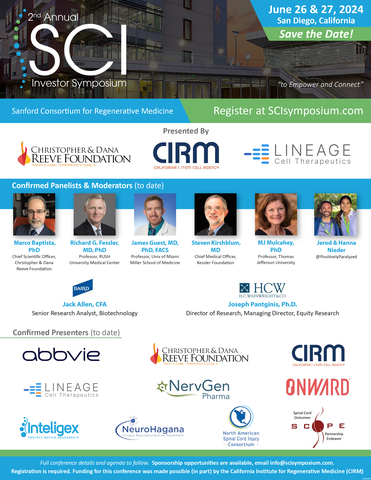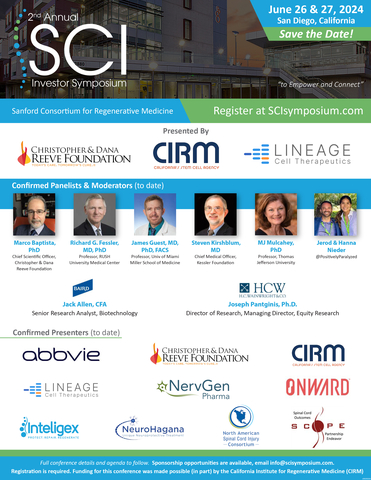CARLSBAD, Calif.--(BUSINESS WIRE)--Lineage Cell Therapeutics, Inc. (NYSE American and TASE: LCTX), a clinical-stage biotechnology company developing allogeneic cell therapies for unmet medical needs, today announced that the Company has received an Education Conference II Grant from the California Institute for Regenerative Medicine (CIRM), to support the 2nd Annual Spinal Cord Injury Investor Symposium ("2nd SCIIS"). The 2nd SCIIS builds upon a successful inaugural event held in 2023 and will connect a diverse set of stakeholders in the field of spinal cord injury (SCI). This year’s event aims to accelerate development in SCI research and treatments by bringing together companies working in the development of treatments for SCI, with regulators, key opinion leaders, persons with lived experience, patient and community advocacy organizations and the investment community, in order to discuss perspectives on current and future treatment alternatives, impact and support SCI disease awareness and clinical trial participation through the implementation of patient appropriate clinical endpoints, and broaden awareness of and investment of capital into SCI.
“This conference was created to foster engagement and collaboration, as well as to bring innovation and modernization to approaches and treatments for spinal cord injury. We are proud to again have the support of CIRM and other leading entities in spinal cord injury advocacy and therapeutic development, as we work to bring greater awareness to the field,” stated Brian M. Culley, Lineage CEO. “In certain rare conditions, raising investor awareness can lead to greater investment, which can help to accelerate new treatments. This funding will enable this year’s symposium to continue to foster open and collaborative dialogue among leading experts, companies, researchers, persons with lived experience, caregivers, advocacy organizations, regulators and members of the investment community."
Current confirmed speakers and moderating healthcare analysts (subject to change), include:
- Richard G. Fessler, M.D., Ph.D., Professor, Department of Neurosurgery, RUSH University Medical Center
- James D. Guest, M.D., Ph.D., Clinical Professor, Department of Neurological Surgery, The Miami Project to Cure Paralysis, Professor, University of Miami Miller School of Medicine
- Mary Jane "MJ" Mulcahey, Ph.D., OTR/L, CPPC, CLCP, FASIA, Professor, Department of Occupational Therapy, Director, Center for Outcomes and Measurement, Professor, Department of Rehabilitation Medicine, Sidney Kimmel Medical College, Thomas Jefferson University
- Steven Kirshblum, M.D., Chief Medical Officer, Kessler Foundation, Professor of Physical Medicine and Rehabilitation, Rutgers New Jersey Medical School
- Marco Baptista, Ph.D., Chief Scientific Officer, Christopher & Dana Reeve Foundation
- Jerod & Hanna Nieder, Positively Paralyzed LLC
- Jack Allen, CFA, Senior Research Analyst, Biotechnology, R.W. Baird & Co., Inc.
- Joseph Pantginis, Ph.D., Director of Research, Managing Director, Equity Research, H.C. Wainwright & Co., Inc.
Additional presenters (subject to change), include:
- AbbVie, Inc.
- California Institute for Regenerative Medicine (CIRM)
- Lineage Cell Therapeutics, Inc.
- NervGen Pharma Corp.
- ONWARD Medical N.V.
- Inteligex
- NeuroHagana Ltd.
- North American Spinal Cord Injury Consortium (NASCIC)
- Spinal Cord Outcomes Partnership Endeavor (SCOPE)
The 2nd Annual Spinal Cord Injury Investor Symposium will be held in-person, on June 26 and 27, 2024, in the Duane Roth Auditorium at the Sanford Consortium for Regenerative Medicine in La Jolla, CA. This event will bring together both public and private companies developing new treatment options for people with spinal cord injury, alongside leaders in the spinal cord injury medical and advocacy communities. A number of important topics will be discussed, including but not limited to preclinical and clinical SCI treatment approaches and the drug development process; racial, ethnic, socioeconomic, geographic vulnerabilities within SCI care and outcomes; hearing the persons with lived experience voice and ensuring patient’s perspectives, needs and priorities are captured in the drug development process; and discussions of SCI clinical endpoints and the need for new and more precise assessment tools.
About the California Institute for Regenerative Medicine (CIRM)
CIRM, California's Stem Cell Agency, was created by the voters of California in 2004 with the passing of Proposition 71, which authorized $3 billion in funding for stem cell research in California. The agency funds stem cell research at institutions and companies throughout California (as well as institutions and companies outside of the state that conduct a portion of their research in California) with the goal of accelerating treatments to patients with unmet medical needs. In 2020, California voters approved to continue funding California's Stem Cell Agency through the passage of Proposition 14. CIRM’s mission is to accelerate world class science to deliver transformative regenerative medicine treatments in an equitable manner to a diverse California and world as well as to accelerate stem cell treatments to patients with unmet medical needs. By promoting and encouraging the growth of the stem cell biotechnology sector, the agency is also helping attract the best scientists to the state and establishing California as a global leader in stem cell research. For more information, please visit https://www.cirm.ca.gov/ and follow the agency on Twitter: @CIRMnews.
About Spinal Cord Injuries
A spinal cord injury occurs when the spinal cord is subjected to a severe crush or contusion and frequently results in severe functional impairment, including limb paralysis, aberrant pain signaling, and loss of bladder control and other body functions. There are approximately 18,000 new spinal cord injuries annually in the U.S. The cost of a lifetime of care for a severe spinal cord injury can be as high as $5 million.
About Lineage Cell Therapeutics, Inc.
Lineage Cell Therapeutics is a clinical-stage biotechnology company developing novel or "off-the-shelf," cell therapies to address unmet medical needs. Lineage’s programs are based on its proprietary cell-based technology platform and associated development and manufacturing capabilities. From this platform, Lineage designs, develops, manufactures, and tests specialized human cells with anatomical and physiological functions similar or identical to cells found naturally in the human body. These cells are created by applying directed differentiation protocols to established, well-characterized, and self-renewing pluripotent cell lines. These protocols generate cells with characteristics associated with specific and desired developmental lineages. Cells derived from such lineages are transplanted into patients in an effort to replace or support cells that are absent or dysfunctional due to degenerative disease, aging, or traumatic injury, and to restore or augment the patient's functional activity. Lineage’s neuroscience focused pipeline currently includes: (i) OpRegen, a retinal pigment epithelial cell therapy in Phase 2a development under a worldwide collaboration with Roche and Genentech, a member of the Roche Group, for the treatment of geographic atrophy secondary to age-related macular degeneration; (ii) OPC1, an oligodendrocyte progenitor cell therapy in Phase 1/2a development for the treatment of spinal cord injuries; (iii) ANP1, an auditory neuronal progenitor cell therapy for the potential treatment of auditory neuropathy; (iv) PNC1, a photoreceptor neural cell therapy for the potential treatment of vision loss due to photoreceptor dysfunction or damage; and (v) RND1, a novel hypoimmune induced pluripotent stem cell line being developed in collaboration with Eterna Therapeutics Inc. For more information, please visit www.lineagecell.com or follow the company on X/Twitter @LineageCell.
Forward-Looking Statements
Lineage cautions you that all statements, other than statements of historical facts, contained in this press release, are forward-looking statements. Forward-looking statements, in some cases, can be identified by terms such as "believe," “aim,” “may,” “will,” “estimate,” “continue,” “anticipate,” “design,” “intend,” “expect,” “could,” “can,” “plan,” “potential,” “predict,” “seek,” “should,” “would,” “contemplate,” “project,” “target,” “tend to,” or the negative version of these words and similar expressions. Such statements include, but are not limited to, statements relating to: the potential effect of the 2nd SCIIS, including accelerating development in SCI research and treatment, broadening SCI disease awareness and investment, or increasing clinical trial participation or affecting trial design. Forward-looking statements involve known and unknown risks, uncertainties and other factors that may cause Lineage’s actual results, performance or achievements to be materially different from future results, performance or achievements expressed or implied by the forward-looking statements in this press release, including, but not limited to, the following risks: that engagement with patients and the advocacy community may not lead to improvements in patient outcomes; and that raising investor awareness may not lead to greater investment, nor accelerate new treatments; and those risks and uncertainties inherent in Lineage’s business and other risks discussed in Lineage’s filings with the Securities and Exchange Commission (SEC). Lineage’s forward-looking statements are based upon its current expectations and involve assumptions that may never materialize or may prove to be incorrect. All forward-looking statements are expressly qualified in their entirety by these cautionary statements. Further information regarding these and other risks is included under the heading “Risk Factors” in Lineage’s periodic reports with the SEC, including Lineage’s most recent Annual Report on Form 10-K and Quarterly Report on Form 10-Q filed with the SEC and its other reports, which are available from the SEC’s website. You are cautioned not to place undue reliance on forward-looking statements, which speak only as of the date on which they were made. Lineage undertakes no obligation to update such statements to reflect events that occur or circumstances that exist after the date on which they were made, except as required by law.




